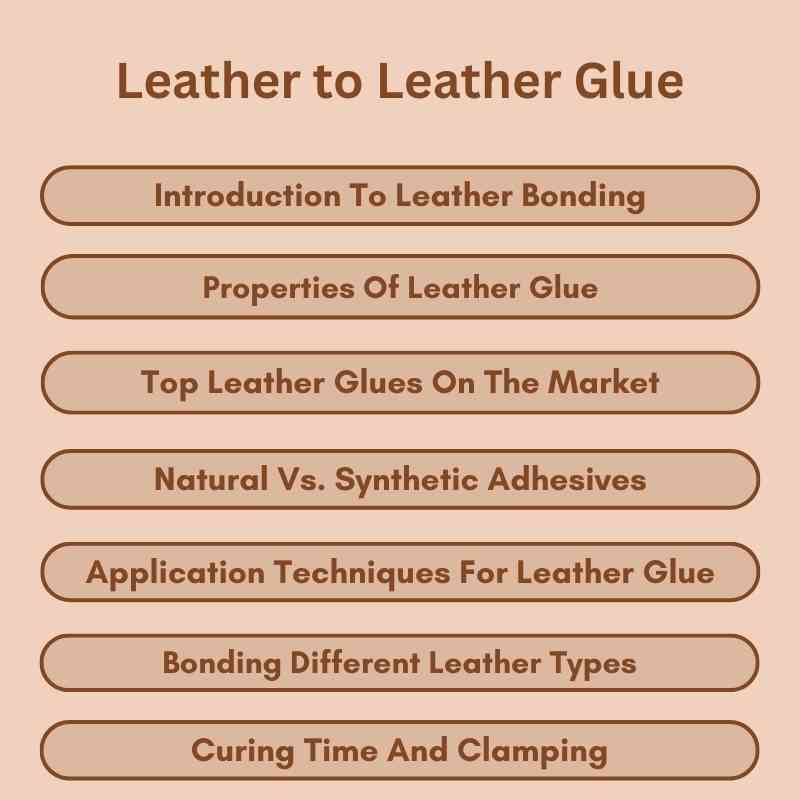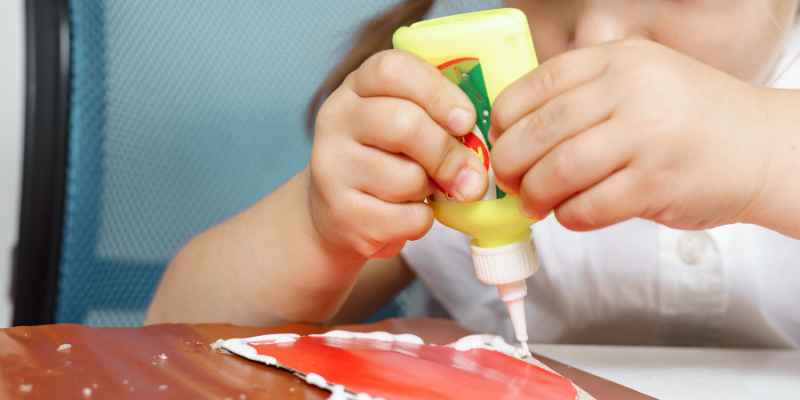Leather glue is specifically formulated to bond leather surfaces effectively. It offers strong adhesion while remaining flexible for various projects.
Choosing the right leather glue is essential for successful crafting and repairs. Leather, known for its durability and beauty, often requires specialized adhesives to maintain its integrity. Whether you’re working on a handbag, upholstery, or crafting a custom piece, the right glue can make all the difference.
Many options are available, from water-based to contact adhesives, each with unique properties. Understanding these differences helps ensure your projects withstand wear and tear. Proper application techniques, such as cleaning surfaces and allowing adequate drying time, further enhance the bond. Selecting high-quality leather glue not only improves durability but also preserves the aesthetic appeal of your leather items.
Introduction To Leather Bonding
Leather bonding is crucial for many crafting projects. Strong adhesives ensure durability and longevity. They hold pieces together, allowing for beautiful creations.
Different types of leather are used in crafting. Here are some common types:
| Type of Leather | Description |
|---|---|
| Full-Grain | Most durable and retains natural markings. |
| Top-Grain | Slightly sanded for a smooth finish, still strong. |
| Genuine Leather | Made from leftover scraps, less durable. |
| Suede | Soft texture, used for clothing and accessories. |

Properties Of Leather Glue
Leather glue offers strong adhesion and great flexibility. It bonds leather pieces tightly. This flexibility allows movement without breaking. Ideal for shoes and bags, it keeps items intact.
Water resistance is another key feature. Leather glue protects against moisture damage. This durability ensures long-lasting repairs. It withstands wear and tear over time. Using high-quality glue helps maintain leather quality.
Top Leather Glues On The Market
Many people enjoy using leather glue for their crafting projects. This glue works well for bonding leather pieces together. Here are some of the top brands available in the market:
| Brand | User Rating | Key Features |
|---|---|---|
| Leather Weld | 4.5/5 | Strong bond, dries clear, flexible |
| Eco-Weld | 4.2/5 | Non-toxic, easy to apply, fast drying |
| Barge All-Purpose Cement | 4.7/5 | Water-resistant, strong hold, versatile |
Users appreciate the strong adhesion and quick drying time of these products. Many reviews mention how easy they are to use. Choose the glue that fits your project needs best.
Natural Vs. Synthetic Adhesives
Natural glues are made from materials like animal hide and plant starch. They are eco-friendly and safe to use. However, they can be less durable than synthetic options. Natural glues may not work well in humid conditions.
Synthetic adhesives offer great strength and flexibility. They resist moisture and temperature changes. This makes them ideal for various projects. Yet, they may contain harmful chemicals. Always check the labels for safety.
| Pros of Natural Glues | Cons of Natural Glues |
|---|---|
| Eco-friendly | Less durable |
| Safe to use | Poor performance in humidity |
| Advantages of Synthetic Options |
|---|
| Strong and flexible |
| Resistant to moisture |
| Suitable for various projects |
Application Techniques For Leather Glue
Proper surface preparation is key for effective leather glue application. Start by cleaning the leather. Use a damp cloth to remove dirt and dust. Make sure the leather is completely dry before applying glue.
For best results, lightly sand the surface where the glue will go. This helps the glue stick better. Use fine-grit sandpaper for this task.
Always test the glue on a small area first. This ensures it does not damage the leather. Choose a high-quality leather glue for strong bonds.
Apply the glue evenly with a brush or applicator. Avoid using too much glue, as this can lead to mess. Press the pieces together firmly after applying glue.
Let the glue dry for the recommended time. This varies by product, so check the label. Proper drying ensures a strong and lasting bond.
Bonding Different Leather Types
Bonding different leather types can be tricky. Each type has unique textures and properties. Some leathers are soft and pliable, while others are stiff and rigid. Finding the right glue is essential for a strong bond.
Challenges arise with various leather textures. Suede and nubuck absorb glue differently than smooth leather. This can lead to weak bonds or unsightly marks. It’s important to choose a glue that works for each type.
| Leather Type | Recommended Glue |
|---|---|
| Soft Leather | Water-based Contact Adhesive |
| Stiff Leather | Leather Cement |
| Suede/Nubuck | Specialized Suede Glue |
Choosing the right glue makes a big difference. Always test a small area first. This ensures the glue won’t damage the leather.
Curing Time And Clamping
Optimal curing conditions are vital for strong leather bonds. Temperature plays a key role in curing. A range of 70°F to 80°F is ideal. Humidity should stay between 40% and 60% for best results.
Using proper clamping methods improves bond strength. Clamps should apply even pressure across the leather surface. Weights can also be used for uniform contact. Allow at least 24 hours for the glue to set properly.
Ensure surfaces are clean and free from dust. This helps the glue bond better. Always follow the manufacturer’s instructions for the best results.
Maintaining Leather Bonds
Long-term care for glued leather items is essential for durability. Regular cleaning helps maintain the leather’s appearance. Use a soft cloth to wipe the surface. Avoid harsh chemicals that can damage the material.
Store leather items in a cool, dry place. This prevents moisture buildup and mold growth. Conditioning the leather every few months keeps it soft and supple. Choose a conditioner that is safe for glued leather.
For repairing leather bonds, use a high-quality leather glue. Clean the surfaces before applying glue. Clamp the pieces together until the glue dries completely. This ensures a strong bond and prevents peeling.
Safety Precautions And Environmental Considerations
Always wear gloves and goggles when using adhesives. Protecting your skin and eyes is very important. Work in a well-ventilated area to avoid harmful fumes. Keep all adhesives away from children and pets.
Use eco-friendly glue options whenever possible. These glues are safer for health and the environment. Look for water-based or plant-based adhesives. They have fewer toxic chemicals and are easier to clean up.
| Eco-Friendly Glue Alternatives | Benefits |
|---|---|
| White Glue | Non-toxic and easy to use |
| Natural Rubber Cement | Biodegradable and strong |
| Casein Glue | Made from milk, safe for kids |
| Starch-Based Adhesives | Safe and non-toxic |

Frequently Asked Questions
What Is Leather To Leather Glue?
Leather to leather glue is a specialized adhesive designed for bonding leather materials. It creates a strong, flexible bond that withstands wear and tear. Ideal for repairs and crafting, it ensures that your leather products maintain their durability and aesthetic appeal.
How Do I Apply Leather Glue?
To apply leather glue, clean both surfaces thoroughly. Use a brush or nozzle to apply a thin layer on one side. Press the pieces together firmly and clamp if necessary. Allow the glue to cure according to the manufacturer’s instructions for the best results.
Can Leather Glue Be Used On Other Materials?
Leather glue is primarily formulated for leather bonding. However, some types may work on fabric or rubber. Always check the product specifications before use. For optimal results, choose an adhesive specifically designed for the materials you intend to bond.
How Long Does Leather Glue Take To Dry?
Drying times for leather glue vary by brand and conditions. Generally, it can take anywhere from 20 minutes to several hours. Full curing may take up to 24 hours. Follow the manufacturer’s guidelines for the specific product you are using to ensure proper adhesion.
Conclusion
Choosing the right leather glue can transform your crafting projects. It ensures durability and a professional finish. Whether you’re repairing items or creating something new, quality adhesive makes all the difference. Explore the options available to find the perfect match for your leatherwork needs.
Your projects deserve the best!

